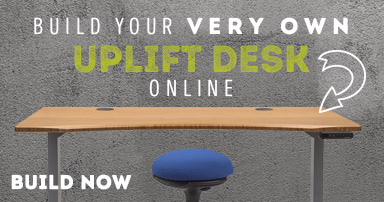Take The Weight Of The World Off Your Shoulders With These Ergonomic Tips
Posted by Human Solution on Sep 11th 2013
I get a lot of questions from customers that are looking for a chair that will help alleviate upper back, shoulder and arm pain. Generally, a chair alone won't alleviate those specific pain areas. An ergonomic office chair is more so designed to target and provide relief for the lower back area, promote good circulation and evenly distribute body weight. There are certain features of a chair to utilize when paired with other ergonomic products and best practices that can help.
Here are some suggestions for those who work in an office environment that tend to feel sore and strained in their shoulders, upper back and even neck:
Keyboard Tray: Bring Your Keyboard To Your Lap -
- A keyboard tray is one of the most important ergonomic accessories and a cornerstone for a full ergonomic workstation setup. It is also the main way I have found to alleviate shoulder and upper back pain and discomfort.
From an ergonomic standpoint, you should be typing near or in your lap so that your arms are at a near 90 degree angle. Typing on your desk surface is usually much too high and this is what forces you to reach and strain just to type for an extended period of time.
If you think about it, you have to use your neck, shoulder and upper back muscles to hold your arms up in that position and you have to use your arms suspended high enough for your hands to type on the desk surface. That is a whole lot of unnecessary straining.
Ergonomic Chair: Use Those Ergonomic Features -
- A good ergonomic chair can be your best friend in an office environment. Sure, that co-worker is a great listener that you vent your personal problems to during lunch, but nothing can compare to how supportive your chair is. It is very important that you get to know your chair and all of its features.
Make sure you are taking advantage of everything it has to offer. Chairs don't mind being taken advantage of. We've written a previous blog post about how to properly adjust your ergonomic chair, but again, here are a few ergo pro-tips:
- Adjust your chair to your body. A good ergonomic chair will have adjustments for seat height and depth as well as adjustable back height and oftentimes an adjustable lower lumbar support. Lumbar support should be just above your belt-line.
- Use those arms. Adjustable arms are important and can help in tandem with a keyboard tray to relieve shoulder and upper back pain. I like to type and work with my keyboard tray in my lap, resting my forearms on the arm pads of my chair while I recline slightly. This position requires little to no movement or stress on any one area or muscle group.
- Lean back. Office chairs tilt and recline for a reason. This takes pressure off your lower back, especially over long periods of time. In addition, if you are reclined slightly, it is easier to position a keyboard tray in your lap and easier for you to reach it, rather than sitting up straight.
In addition to a keyboard tray and ergonomic chair, there is just no substitute for good posture habits and reminding yourself to use correct posture if you find yourself sitting in an awkward or uncomfortable position at times throughout the day. With my ergonomic setup, it only takes a couple of minutes of incorrect posture, reaching too far to type, ect. to feel the burn and strain in my shoulders and upper back. Then I just remember these tips and settle back into my ergo-routine. Sometimes the simplest answer is the solution.
Try the tips above and leave some tips of your own in the comments below!
Check out TheHumanSolution.com for the latest in ergonomics or contact usfor expert advice.




